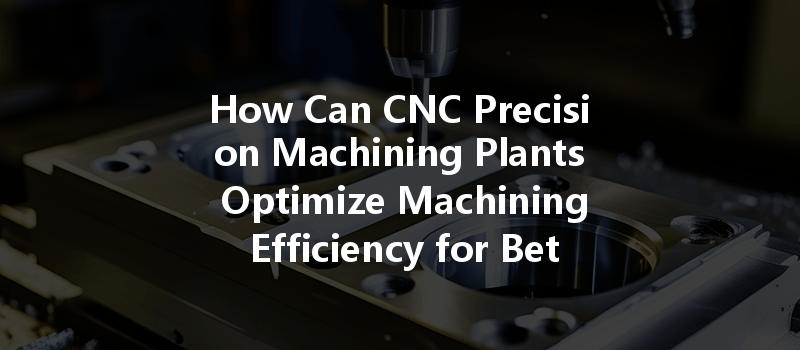Did you know that according to a survey by the Manufacturing Institute, more than 80% of manufacturers consider optimizing operational efficiency to be their top priority? In an industry that demands precision, speed, and cost-effectiveness, CNC (Computer Numerical Control) machining plants are under constant pressure to improve their machining efficiency. But what exactly does “machining efficiency” mean, and how can CNC precision machining plants achieve it? In this blog, we will explore effective strategies, tools, and best practices that can significantly enhance performance in CNC machining, leading to better production outcomes.
Understanding CNC Machining Efficiency
Before delving into optimization strategies, it is essential to understand what CNC machining efficiency entails. Machining efficiency can be defined as the ratio of the productive time spent on machining operations to the total time used, which includes setup, tool changes, and idle time. In an ideal scenario, a CNC machine should spend the maximum time cutting or machining parts, while minimizing the time spent on non-productive activities.
Key Components of Machining Efficiency
Challenges Faced by CNC Precision Machining Plants
Machining plants face numerous challenges that affect their efficiency, including:
The key to overcoming these challenges lies in a combination of technology, strategy, and constant improvement.
Strategies for Optimizing Machining Efficiency
Now let’s delve into practical and detailed strategies that CNC precision machining plants can adopt to enhance their machining efficiency.
a. CNC Machines
The first step in optimizing machining efficiency is ensuring you use modern, high-performance CNC machines. Upgrading to cutting-edge technology can significantly decrease machining time and improve accuracy. Features such as high-speed machining, multi-axis capabilities, and automated tool changers can substantially enhance productivity.
b. Software Solutions
Implementing advanced software systems such as CAM (Computer-Aided Manufacturing) can optimize tool paths and improve machine utilization. Software can simulate workflows, allowing operators to identify inefficiencies before production even begins.
a. Tool Selection
Selecting the right tooling for the specific materials and operations can influence the overall efficiency of CNC machining plants. High-quality tools with proper geometry suited for the job can enhance cutting speeds and reduce wear.
b. Tool Maintenance
Regular maintenance of tools is crucial to ensure their longevity and optimal performance. Implementing a scheduled maintenance program can avoid unexpected downtimes caused by tool breakdowns.

a. Layout Optimization
An efficient layout of machines and workstations reduces unnecessary movement and boosts productivity. Employing lean manufacturing principles such as value stream mapping can help identify inefficiencies in workflows.
b. Communication
Fostering open communication among teams can help address issues quickly. Regular team meetings that focus on performance metrics and improvement strategies can align everyone’s efforts towards enhancing machining efficiency.
a. Speed and Feed Rate
Adjusting cutting speeds and feed rates can dramatically impact cycle time and part quality. Conducting regular analyses can help determine the optimal parameters for various materials.
b. Cooling Systems
Implementing effective cooling systems reduces heat generated during machining, preventing tool wear and ensuring part quality. Mist systems, flood cooling, or air cooling can be evaluated based on specific operations.
a. Continuous Improvement Programs
Establishing a culture focused on continuous improvement fosters innovation and boosts employee morale. Techniques like Six Sigma and Kaizen can help to systematically identify areas for enhancement.
b. Automation
Incorporating automated solutions can alleviate workloads and minimize human error. Robotic arms for material handling, automated inspection systems, and IoT-enabled monitoring solutions can streamline processes and increase productivity.
Investing in employee training is vital for operational success. Well-trained employees can troubleshoot issues, maintain machines, and optimize processes, leading to better production outcomes. Regular workshops and certifications can keep the workforce updated with the latest technologies and methodologies.
Measuring Success: Key Performance Indicators (KPIs)
To track improvements in machining efficiency, CNC precision machining plants should implement KPIs that align with their goals. Important KPIs may include:
In the highly competitive landscape of CNC precision machining, optimizing machining efficiency is paramount for success. By investing in advanced technology, optimizing tooling, streamlining workflows, controlling machining parameters, implementing continuous improvement practices, and focusing on employee training, CNC machining plants can enhance their operational capabilities.
This blog has outlined actionable strategies to effectively boost machining efficiency, which will ultimately lead to improved production outcomes. Adopting these best practices is not an optional enhancement, but a necessity for obtaining a competitive edge in the industry.
As you consider the importance of machining efficiency within your own operations, remember that each adjustment you make can significantly impact your company’s bottom line. In today’s demanding marketplace, improving efficiency is not only beneficial — it is essential. Every point of optimization translates into cost savings, improved quality, and increased customer satisfaction.
Constantly strive for improvement; it is the key to sustained success in the CNC machining industry.






